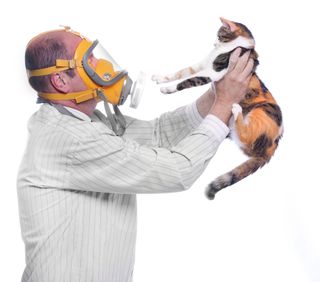New Pet Therapy Guidelines: No Cats in Hospitals

A visit from a furry companion can give comfort to patients in the hospital, but new guidelines recommend that only dogs — and not cats — be allowed in hospitals for pet therapy programs.
The guidelines, from the Society for Healthcare Epidemiology of America (SHEA), are aimed at reducing the potential risks from having animals in hospital facilities.
In recent years, it has become more common for hospitals to allow the presence of animals, such as service animals, trained therapy animals, personal pets and research animals. However, little is known about the risks that animals in hospitals may pose in terms of transmitting diseases to people, and hospital policies on animal visits vary widely among institutions, SHEA says.
"While there may be benefits to patient care, the role of animals in the spread of bacteria is not well understood. We have developed standard infection prevention and control guidance to help protect patients and health care providers," Dr. David Weber, a lead author of the recommendations, said in a statement.
To devise the new guidelines, a committee of experts reviewed information from studies on animals in health care settings, as well as existing hospital policies and a survey of more than 300 SHEA members.
For pet therapy, the guidelines recommend that only dogs that are at least 1 year old be used. "Cats should be excluded," the guidelines continue, "because they cannot be trained to reliably provide safe interactions with patients in the health care setting." What's more, people are more likely to be allergic to cats than to dogs, and cats may pose an increased risk for bites and scratches compared to trained dogs, the recommendations say.
The guidelines also say that the dogs used in pet therapy programs should undergo formal training and evaluation for their behavior in a health care setting, before they are allowed to visit; the dogs' handlers should also undergo formal training. Hospitals should consider using animals that have been certified by pet therapy training organizations, the guidelines said.
Sign up for the Live Science daily newsletter now
Get the world’s most fascinating discoveries delivered straight to your inbox.
Pet therapy animals should also be evaluated by a veterinarian once per year, and should be vaccinated against rabies. They should be combed before entering the hospital to remove as much loose hair and dander as possible, and should avoid contact with invasive devices (such as catheters), bandages or parts of the body with damaged skin, the guidelines say. In addition, patients should not eat or drink while they play with the animals, and any people who touch the animals should wash their hands before and afterward. [7 Surprising Health Benefits of Dog Ownership]
In general, hospitals should prohibit their patients' personal pets from visiting the facility, the guidelines say. Personal pets don't usually have the same formal training as therapy animals, and it may be hard to prevent patients other than the owner from encountering a visiting pet.
But there can be exceptions if doctors determine that a pet visit would benefit the patient, and that it can happen with limited risk to the owner and other patients, the guidelines say. Doctors might consider allowing a pet visit in cases of a terminally ill patient, a patient who has been hospitalized for a long time or patients who have close bonds with their pets.
As with therapy animals, pet visits should be restricted to dogs, the guidelines say. Pets generally should not be allowed to visit patients in isolation, patients in the intensive care unit (IUC) or those who have recently undergone organ transplants.
There have been very few studies on whether animals in hospitals can transmit diseases. But a 2006 study of 100 dogs in hospitals in Ontario found that about 80 percent of those animals carried potentially harmful bacteria, including Clostridium difficile and Salmonella. However, the study did not look at whether the animals could transmit the diseases to patients, and in the United States, the Centers for Disease Control and Prevention has never received a report of an infection related to pet therapy, according to the Mayo Clinic.
Because of the lack of information about risks from pets in hospitals, the new guidelines should be viewed as "suggested actions to consider in the absence of a recognized standard or regulation," the authors said.
"Adoption and implementation of these recommendations (including allowing the use of cats) should occur at the discretion of individual institutions based on a risk assessment for their patients," Dr. Rekha Murthy, a co-lead author of the guidelines, told Live Science in an email.
The new guidelines are intended only for acute care hospitals and ambulatory care facilities, and not for assisted living facilities or nursing homes.
The guidelines were published Monday (March 2) in the journal Infection Control & Hospital Epidemiology.
Follow Rachael Rettner @RachaelRettner. Follow Live Science @livescience, Facebook & Google+. Original article on Live Science.

Rachael is a Live Science contributor, and was a former channel editor and senior writer for Live Science between 2010 and 2022. She has a master's degree in journalism from New York University's Science, Health and Environmental Reporting Program. She also holds a B.S. in molecular biology and an M.S. in biology from the University of California, San Diego. Her work has appeared in Scienceline, The Washington Post and Scientific American.

Packs of dog-shaped robots could one day roam the moon — if they can find their footing on Earth first

See the explosive 'devil comet' get its tail ripped off by a solar storm days before its close approach to the sun

Global 'time signals' subtly shifted as the total solar eclipse reshaped Earth's upper atmosphere, new data shows
Most Popular

